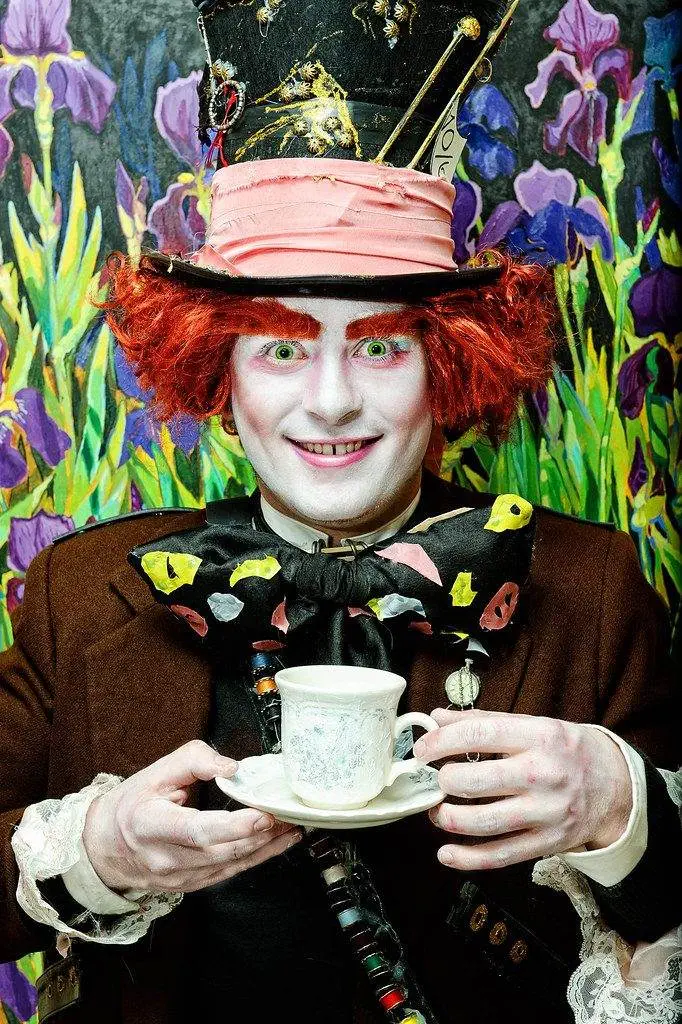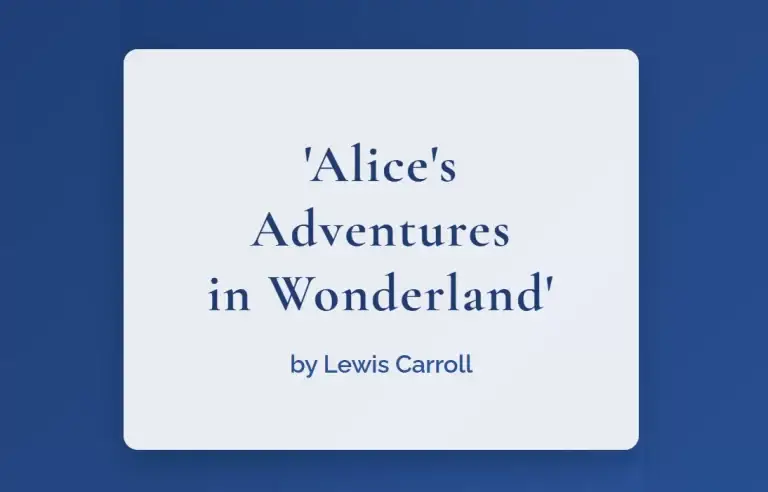Published in 1865, Alice’s Adventures in Wonderland by Charles Lutwidge Dodgson (under the pseudonym Lewis Carroll) is a beloved children’s book that has enchanted readers across generations. It tells the surreal tale of young Alice who falls through a rabbit hole into the magical and bizarre world of Wonderland populated by anthropomorphic creatures, talking animals and playing cards.
Table of Contents
Full of wordplay, logic puzzles and whimsical imaginative adventures, Alice’s Adventures in Wonderland is considered a literary classic.
Summary and Plot
The story begins on a sunny day when seven-year old Alice, bored sitting by the riverbank with her sister, sees a talking white rabbit in a waistcoat passing by who seems to be in a hurry. Curious, she follows him and falls down a large rabbit hole into a fantasy realm called Wonderland.
As she tumbles down, she has visions of strange objects and scenes. She lands in a hall with many doors but is too big to fit through any of them. She finds a bottle labeled “Drink Me” which causes her to shrink. Now small, she is able to pass through a tiny door into a magical garden. This begins a series of bizarre adventures where Alice meets various eccentric characters – a grinning cat, a blue caterpillar, the rude Duchess and Cook, the Mad Hatter and the March Hare who have a mad tea party, a suppressing Queen and her guards who play croquet using flamingos and hedgehogs.
Alice’s size changes unpredictably whenever she eats or drinks something. She starts out petite, grows unnaturally tall in some scenes and shrinks tiny in others. These size fluctuations symbolize the instability of identity and reality. After overcoming many challenges, Alice wakes up from what seems to have been a vivid dream.
Themes and Analysis
Some of the key themes and ideas explored in Alice’s Adventures in Wonderland are:
- The contrast between logic and absurdity, sense and nonsense
- Dreams, reality and the question of what is real
- Fluidity of size and identity
- Power dynamics between youth and authority figures
- The arbitrariness of social conventions and rules
- The discord between natural childhood innocence and adult corruption

Carroll employs fantasy, anthropomorphism and absurdist techniques to create a topsy-turvy world where illogic prevails over reason and common sense. The novel uses parody and reversal effectively to poke fun at rigid Victorian morality and education. The strange dreamscape reflects the malleability of reality through a child’s eyes. The book revels in imaginative nonsense verse, puns and wordplay. Through parody and irony, it exposes hypocrisies in society. Alice serves as an empathetic guide exploring this mad new world. Her curious nature, courage and determination make her an iconic literary heroine.
Lewis Carroll and Background
Charles Dodgson was a mathematics professor at Oxford University in England. Under the pseudonym Lewis Carroll, he published several classic fantasy stories starting with Alice’s Adventures Underground in 1865, which later became Alice’s Adventures in Wonderland.
As a mathematician, Lewis Carroll incorporated symbolic logic, linguistic philosophy and mathematical concepts into his fantastical tales. Dodgson was also an innovator in photography and a progressive thinker who challenged social conventions.
Some key contextual factors relevant to the novel include:
- The Victorian era with its expansion of the British Empire, industrialization and social reforms
- Rise of children’s literature as a genre
- Invention of photography and Carroll’s own contributions
- Mathematic innovations and growing interest in logic and linguistics
- Social repression and rigid rules which Carroll reacted against
Lewis Carroll originally invented the Alice stories for the daughters of a college Dean to entertain them on boat rides. Eventually at their insistence, he published the book which became an immediate success and has enchanted children and adults since.
Analysis of Characters
Alice – A seven-year old girl with a curious mind who finds herself in a fantasy world. She is courteous but courageous in confronting situations. Her fluctuating size represents identity instability.
The White Rabbit – A nervous anthropomorphic rabbit dressed in a waistcoat, always hurrying and worrying about the time. He leads Alice into Wonderland and represents the idea of time governing life pointlessly.
The Cheshire Cat – A grinning, sly cat who speaks in riddles and rhyming words. He symbolizes philosophy, arrogance, madness and the irrationality of Wonderland.
The Queen of Hearts – The foul-tempered monarch who always orders beheadings and represents abuse of power. Her interactions with Alice show youth challenging corruption.
The Mad Hatter – An eccentric hatter having an endless tea party with the March Hare. He represents insanity and suspension of time. His nonsensical logic reveals the absurdities of Wonderland.

The Duchess – A volatile, hideous noblewoman who nurses a baby that turns into a pig. She embodies grim reality beneath a harmless facade.
The King and Queen of Hearts – The tyrannical but incompetent monarchs who abuse power. Their flawed trials mock legal corruption.
Read Tis Too: Ode to the West Wind: Poem Overview for UGC NET 2024
Legacy and Influence
As a pioneering fantasy novel, Alice’s Adventures in Wonderland has been tremendously influential:
- Its imaginative world, vivid characters and dreamlike absurdism inspired the surrealism movement.
- It expanded children’s literature from moralistic stories to nonsensical fantasy and whimsy.
- Carroll’s stylistic innovations like portmanteau words, poetry and parody became traditions in fantasy writing.
- It has been adapted extensively into plays, musicals, animated and live action films by Disney, Tim Burton and others.
- Illustrations by John Tenniel, Arthur Rackham established iconic visual representations still used.
- It has inspired countless literary works across genres especially in magical realism and fantasy fiction.
- Memorably whimsical characters like the Mad Hatter and Cheshire Cat are cultural icons.
- Phrases like “down the rabbit hole”, “curiouser and curiouser” entered the popular lexicon.
- It has been analysed from philosophical, psychoanalytic, political and other perspectives extensively.
- It popularised literary nonsense verse and the tradition continues today, including poets like Edward Lear.
Why Read Alice’s Adventures in Wonderland
There are several reasons why Alice’s Adventures in Wonderland is a beloved classic:
- It created the nonsense fantasy genre that became a monumental legacy.
- It pioneered anthropomorphism in children’s literature that is now standard.
- Carroll’s magical world is immersive, wildly creative and unforgettable.
- The clever wordplay, puns and parody are humorously entertaining.
- The absurd dream logic satirizes hypocrisies, arbitrary rules and power structures.
- Alice is an iconic literary heroine with an unquenchable curiosity and spirit.
- It appeals simultaneously to children and adults with its multiple layers.
- The imaginative creatures are wonderfully quirky, bizarre and amusing.

- It explores philosophy on identity, reality, meaning and nature of sanity through fantasy.
- The blurred lines between dreams and reality resonate profoundly.
Conclusion
With its brilliant wordplay, vivid fantasy universe and iconic characters, Alice’s Adventures in Wonderland pioneered the children’s literature genre and nonsense verse traditions. Its clever parody of society along with surreal dream logic make it a genuinely subversive work. The ultimate puzzle book, it has captured readers’ imaginations for over 150 years and will doubtlessly continue to charm future generations. Alice’s timeless adventures in Wonderland prove that sanity is overrated.
Read This Too: My Last Duchess: Poem Analysis | Robert Browning


